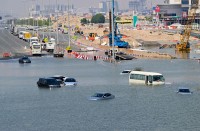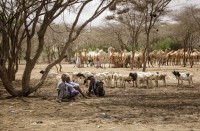by Abdulkarim AL-MARANI with Dana MOUKHALLATI in Dubai
Agence France Presse
Sanaa, Yemen (AFP) — Yemen’s war makes life a daily struggle for millions of civilians, but creatures in the country’s neglected zoos, including lions, leopards and baboons also face an uncertain future.
At the country’s main zoo in Sanaa, the capital seized in 2014 by the Iran-backed Huthi militias who control much of the north, a man unloaded one of a dozen dead donkeys trucked in each day to feed 31 resident lions.
Lion keeper Amin al-Majdi said some animals, including four lions that perished in 2017, have already starved to death.
“We import meat from all provinces of the country, but we are struggling with this because of the increase in the price of donkeys,” he told AFP.
“We used to slaughter three or four donkeys for six lions, now with 31 we have to slaughter 10 to 12 donkeys.”
Like the rest of the country, where millions have been driven to the brink of famine after five years of conflict, the zoo’s 1,159 animals, which include two critically endangered Arabian leopards, are at risk.
Among those fighting on behalf of the animals is Kim-Michelle Broderick, founder of One World Actors Animal Rescues, which raises funds to keep Yemen’s zoo creatures alive.
Of the country’s three main zoos, the one in Sanaa is in better condition than others in the cities of Taez and Ibb, she said, but added all are in poor condition.
“The public authorities are destitute because of the war,” she said. “The animals are underfed or hardly fed, or not fed at all in the case of Ibb zoo.”
With the help of coordinators on the ground, the organisation conducts rescues across Yemen, she said, distributes emergency food and water, and provides basic veterinary treatment to horses, other farm animals and strays.
The lions in Sanaa zoo look relatively healthy compared to big cats in other regional zoos, where emaciated animals have elicited outrage.
A team of international wildlife conservationists recently flew to the Sudanese capital of Khartoum, to examine four starving and sick lions at a zoo where a lioness died earlier this month.
But Sanaa zoo authorities said they are struggling to feed their animals, with rampant inflation making supplies expensive, and the number of visitors plummeting since the war broke out.
“We are facing a lot of challenges,” the zoo’s deputy director Mohammed Abu Aoun told AFP. “Our only revenue comes from visitors, the sale of tickets.”
The zoo currently makes two to three million riyals ($3,300 to $5,000) per month, he said, not enough to feed the animals and pay employee salaries.
Tens of thousands of people, most of them civilians, have been killed and millions have been displaced in the conflict in Yemen, which the United Nations says is gripped by the world’s worst humanitarian crisis.
But the Sanaa zoo is one of the few places to provide an outlet for people stuck in years of grinding conflict.
“The zoo these days has become the only breath of fresh air… we only see destruction, war and aggression,” said one visitor, Tawheed al-Thahbi.
str-dm/sls/cm/jkb
© Agence France-Presse







